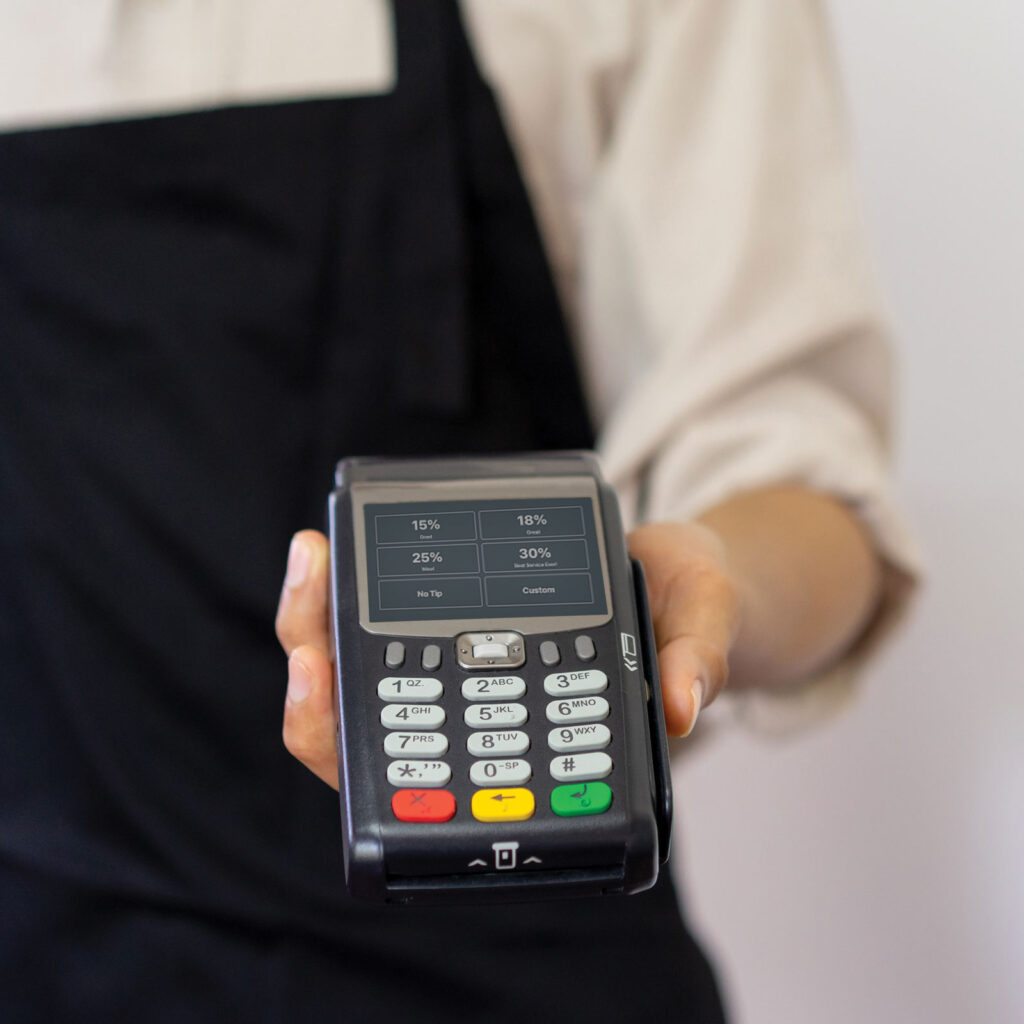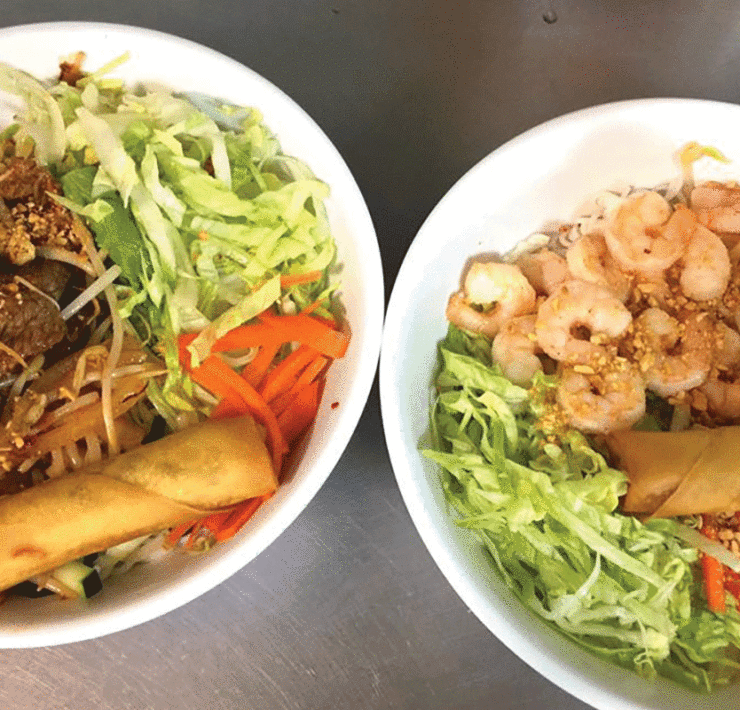Tipping Point
- "Tipping Point" originally appeared in the October 2024 "Finance" issue of COMO Magazine.

Gratuities are a custom, but they can also cause a conundrum.
Tipping is deeply baked into American culture. In movies and on TV shows, tipping is often used to illustrate morality. One of my favorite examples is an episode of 3rd Rock From the Sun, in which John Lithgow’s character — a buffoonish alien commander living in human form, for those unfamiliar with the premise — struggles with the concept of tipping.
“And that’s why your drink always has that funny taste,” another character tells him.
I saw that episode when it aired in 1999, and that line has stayed with me for the past twenty-five years. I do not want my drinks to have that funny taste.
Of course, it’s not just servers and bartenders who earn tips. For decades, it’s been customary to tip hairstylists, manicurists, taxi drivers, valets, housekeepers, and baggage porters.
But more recently, some ambiguity as to whom to tip and how much is appropriate has creeped into the conversation. In a 2023 Pew Research Center survey, only about a third of respondents indicated they felt confident in all tipping situations.
Believe it or not, tipping started as an affectation.
During the mid-1800s, Americans traveling through Europe were charmed by the continental custom of passing a little extra coin to those in the lower class as tokens of appreciation for their services. Much like your college roommate who studied abroad for a semester and came home with a strange accent and an obsession with cigarettes, these tourists decided to infuse a little Euro flair into their lives when they returned home. Eau-là-là!
And just as you probably reacted to this roommate, most Americans found that pretense off-putting. That is until after the Emancipation Proclamation, when restaurants, hotels, and passenger train companies started “hiring” formerly enslaved people. According to the Shriver Center on Poverty Law, those workers didn’t receive wages from their employers. Rather, they relied on tips from their patrons.
Today, most businesses are required to pay employees a federal or state-mandated minimum wage. The notable exception is restaurants, which are allowed to pay half the minimum wage as long as their employees can make up the other half by earning tips.
The new normal of tipping seems to have started during the pandemic, when it became common to tip more generously to show our appreciation for the essential workers who kept our daily lives afloat while we hunkered in place. That shopper delivering our groceries to our front door or the restaurant server bringing out our curbside takeout order were putting a lot on the line to keep us fed. We could afford to shell out a little more.
Then there was the proliferation of customer-facing point-of-sale (POS) devices. You know, those handheld card readers some restaurant servers will bring to your table in lieu of dropping off a paper bill or those iPad-looking terminals you see on the counter at coffee shops or fast-casual restaurants. They’re great because they streamline ordering and check-out processes, but they can cause confusion when they automatically prompt people to tip in places they haven’t tipped in the past.
In short, many of us have been tipping higher amounts and in more instances. According to the aforementioned Pew survey, 72 percent of U.S. adults say tipping is expected in more places than it was five years ago. The phenomenon has been referred to as “tipflation” or “tip creep,” and if you want to see a lively discussion you should definitely post about it on social media.
Former Servers Weigh In
A report by the mobile payment company SpotOn found that almost a quarter of hospitality workers receive half or more of their incomes in tip form. Ketti Horton, an animal sciences major at the University of Missouri who until very recently worked as a server at Addison’s South for three and a half years, says that was the case for her.
“I don’t think I ever saw a paycheck for over $100 for two weeks,” Horton said. “Pretty much my entire income was based on tips.”
Horton said she understands how those who haven’t worked in the industry might not understand the nuances of restaurant life and where their tip money actually goes.
Practices vary from restaurant to restaurant, but oftentimes a server has to reimburse the restaurant for card processing fees when they’re not tipped cash. Additionally, servers often have to “tip out” other members of the staff. Horton said bussers received a small percentage of total food sales, and she was required to give the bar staff 10 percent of her total tips. “No matter what, 10 percent is the total tip-out, even if you didn’t have any drinks made for you,” she noted.
So perhaps it’s no surprise Horton is an enthusiastic tipper when she goes out to eat.
“Being in the service industry for a long time, I definitely don’t think I’ll ever tip below 20 percent. I’m usually at about 25 to 30 percent,” she explained.
Once on a date, her dining companion handed her the receipt and asked her to calculate the tip for him. Being from Australia, the young man told her, he wasn’t well-versed in American tipping culture, but he knew it was important.
“That got him a second date,” Horton said.
For Cindy Sheltmire, a recently retired Realtor, a stint as a server at a pancake house during her college years at St. Louis’ Lindenwood University has informed her approach to tipping at restaurants.
“I’ve always been a good tipper because of it,” Sheltmire said. “I always tip 20 percent or more.”
But even so, she has her limits.
“I was aghast the first time I went into Dairy Queen and they turned that thing around,” Sheltmire said, referring to the store’s POS tablet. “Nobody waited on me except to take my order. To me, that’s not worth a tip. Tipping, in my mind, is for service that goes above and beyond.”
But there’s something about those POS devices that feels insistent. The screens are so bright, and the displays are so large. They’re designed in such a way that the suggested tip amounts are presented front and center. You have to slow down to navigate to the “no tip” or “custom tip” options.
And even when the employee studiously turns around while you complete the transaction, it can be hard not to feel put on the spot.
“You feel annoyed and pressured,” Sheltmire says. “I will admit, there are times I just say ‘no tip.’ Did anybody bring anything to my table or do anything worthy of a tip? Once in a while, I might do ‘custom’ and throw a dollar out. I figure, ‘Well, they have been standing here all day.’ But where does it end?”
Horton explained she has a hard time choosing not to tip — solidarity among service-industry veterans runs deep — but she is concerned that the wider practice of businesses soliciting tips for employees who are paid minimum wage or higher will eventually affect workers who rely on tips.
“People see these tipping options all the time and they’re getting sick of it. That translates into, ‘I don’t want to tip at all anymore,’” Horton said.
She’s not imagining this. Recent data from the digital payroll company Gusto, shows a 75 percent increase in the number of retail businesses accepting tips over the past five years. Meanwhile, a report from the restaurant management software company Toast indicates a slight dip in tipping at full-service restaurants. In 2024’s second quarter, the average restaurant tip was 18.8 percent, down from 19.8 percent in 2021’s fourth quarter.
Beep! Beep! The Delivery Drivers are Here
One factor contributing to tip confusion is the emergence of new industries. App-based delivery services like DoorDash, Grubhub, and Instacart advertise convenience, but they’re not typically transparent on how the drivers are paid.
You might notice in-app prices are sometimes higher than they are in stores. You might also notice surcharges and fees. But most of this money doesn’t make it to your driver.
Last April, Melissa Williams and her husband signed up to DoorDash together. On Fridays, they average ten to fifteen deliveries. On Saturdays and Sundays, they might make thirty to forty.
Unlike servers in restaurants, DoorDashers have the option of being paid $12.50/hour or base pay — typically $2 or $4 depending on the distance of the delivery — plus tips. Williams said she and her husband usually choose the tip option, though they sometimes switch to hourly pay on especially busy days. But unlike servers in restaurants, who might have multiple tables going at once, DoorDashers don’t have as many tip-earning opportunities each shift.
So what’s the appropriate way to tip for delivery? Williams suggests tipping based on the distance the driver has to travel rather than a percentage of the order total.
“If I’m going a quarter a mile and you’ve ordered a $90 meal, I don’t expect you to tip me 20 percent of that. For us, tipping based on how far away you are is a better suggestion,” Williams explained. “If I’m looking at an order and it’s eight miles away and they tip $10 plus the $2 from DoorDash, that’s a good rate. If it’s twenty miles, I’m probably going to pass on that one.”
Kelly Roberts takes a two-part approach to tipping for delivery.
“I feel somebody deserves more than $2 if they’re going to drive across town to bring me my Chicken Salad Chick,” said Roberts, who briefly drove for DoorDash herself. “I always pre-tip about $5. That gives them $7, so that should cover gas and a soda. Then I always contact my driver when they’re picking up my food and let them know I have specific instructions.”
For Williams, DoorDashing is a means of realizing a dream deferred. At first, she and her husband used the money they earned to catch up on bills. Now, they’re saving up to celebrate their thirteenth wedding anniversary next year with a whirlwind vacation — their first-ever trip that will be just the two of them — that will take them from Salem, Massachusetts, to Gettysburg, Pennsylvania, to Covington, Georgia — where The Vampire Diaries was filmed — and then on to New Orleans, where they will take in the Halloween festivities.

A Different Take on Tipping
Ben Voeller, a local rental property owner, said that while he doesn’t approve of the automated tip requests that pop up at POS terminals — he says it gives him the sense that some business owners are trying to cut labor costs and pass the expense to consumers — he does find intriguing the idea of planning to tip a certain amount annually.
“If I said, ‘I’m going to spend $1,000 a year on tips,’ I’d say that’s a manageable number for me,” Voeller says. “When you’re tipping $20, it feels like a lot. But if you add it up over time, you might find that it’s far less than that.”
Voeller’s personal stance on tipping has evolved over the years.
“I used to be one of those people who said, ‘Why should I have to tip someone who’s not necessarily doing an exceptional job just because their employer won’t pay them enough?’” Voeller says.
Why the change of heart?
“Part of it is I no longer work by the hour. When you work by the hour, everything you do can be equated to how much of your time is being taken,” Voeller explained. “If I’m making $20 an hour and I give somebody $10, that’s half an hour out of my life. Now with farm and rental income, that money is being made whether I’m on the clock or not. It’s easier for me to be generous when I don’t equate it to, ‘Well, now I have to work an hour to make up this tip I gave.’”
He also sees generosity as a “be the change you wish to see in the world” sort of mentality.
“I do believe we have a responsibility to share our good fortune with those who are less fortunate,” Voeller says. “I’m just trying to live my conservative principles.”
He’s made it a practice to carry cash to tip not only restaurant servers but anyone else who goes above and beyond on his behalf. He adds, “I’m happy to see people’s pleasure in response.”








